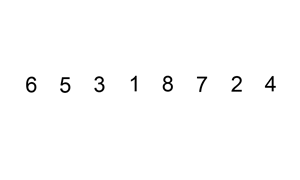Java每日一练(20230324)

目录
1. 链表插入排序 🌟🌟
2. 最接近的三数之和 🌟🌟
3. 寻找旋转排序数组中的最小值 🌟🌟
🌟 每日一练刷题专栏 🌟
Golang每日一练 专栏
Python每日一练 专栏
C/C++每日一练 专栏
Java每日一练 专栏
1. 链表插入排序
对链表进行插入排序。

插入排序的动画演示如上。从第一个元素开始,该链表可以被认为已经部分排序(用黑色表示)。
每次迭代时,从输入数据中移除一个元素(用红色表示),并原地将其插入到已排好序的链表中。
插入排序算法:
- 插入排序是迭代的,每次只移动一个元素,直到所有元素可以形成一个有序的输出列表。
- 每次迭代中,插入排序只从输入数据中移除一个待排序的元素,找到它在序列中适当的位置,并将其插入。
- 重复直到所有输入数据插入完为止。
示例 1:
输入: 4->2->1->3 输出: 1->2->3->4
示例 2:
输入: -1->5->3->4->0 输出: -1->0->3->4->5
出处:
https://edu.csdn.net/practice/23630781
代码:
import java.util.Arrays;
public class insertionSortList {
public static class ListNode {
int val;
ListNode next;
ListNode(int x) { val = x; }
}
public static ListNode createLinkedList(int[] nums) {
if (nums == null || nums.length == 0) {
return null;
}
ListNode head = new ListNode(nums[0]);
ListNode cur = head;
for (int i = 1; i < nums.length; i++) {
cur.next = new ListNode(nums[i]);
cur = cur.next;
}
return head;
}
public static void printLinkedList(ListNode head) {
ListNode cur = head;
while (cur != null) {
System.out.print(cur.val + "->");
cur = cur.next;
}
System.out.println("null");
}
public static class Solution {
public ListNode insertionSortList(ListNode head) {
if (head == null)
return head;
ListNode res = new ListNode(head.val);
ListNode left = head.next;
while ((left != null)) {
ListNode cur = left;
left = left.next;
if (cur.val <= res.val) {
cur.next = res;
res = cur;
continue;
}
ListNode p = res;
ListNode last = p;
while (p != null && p.val < cur.val) {
last = p;
p = p.next;
}
last.next = cur;
last.next.next = p;
}
return res;
}
}
public static void main(String[] args) {
Solution s = new Solution();
int[] nums = {4,2,1,3};
ListNode head = createLinkedList(nums);
printLinkedList(head);
head = s.insertionSortList(head);
printLinkedList(head);
int[] nums2 = {-1,5,3,4,0};
head = createLinkedList(nums2);
printLinkedList(head);
head = s.insertionSortList(head);
printLinkedList(head);
}
}输出:
4->2->1->3->null
1->2->3->4->null
-1->5->3->4->0->null
-1->0->3->4->5->null
2. 最接近的三数之和
给定一个包括 n 个整数的数组 nums 和 一个目标值 target。找出 nums 中的三个整数,使得它们的和与 target 最接近。返回这三个数的和。假定每组输入只存在唯一答案。
示例:
输入:nums = [-1,2,1,-4], target = 1 输出:2 解释:与 target 最接近的和是 2 (-1 + 2 + 1 = 2) 。
提示:
3 <= nums.length <= 10^3-10^3 <= nums[i] <= 10^3-10^4 <= target <= 10^4
出处:
https://edu.csdn.net/practice/23630782
代码:
import java.util.Arrays;
public class threeSumClosest {
public static class Solution {
public int oneSumCloset(int[] nums, int i, int j, int start, int end, int target) {
if (start == i || start == j)
start = start + 1;
if (end == i || end == j)
end = end - 1;
if (start == end) {
return nums[start];
} else if (end == start + 1 || end == start - 1) {
if (Math.abs(nums[end] - target) > Math.abs(nums[start] - target)) {
return nums[start];
} else {
return nums[end];
}
} else {
int middle = (int) Math.floor((start + end) / 2);
if (nums[middle] > target) {
end = middle;
} else {
start = middle;
}
return oneSumCloset(nums, i, j, start, end, target);
}
}
public int threeSumClosest(int[] nums, int target) {
Arrays.sort(nums);
int minValue = 0;
boolean hasMin = false;
for (int i = 0; i < nums.length - 2; i++) {
for (int j = i + 1; j < nums.length - 1; j++) {
int twoSum = nums[i] + nums[j];
int rest = target - twoSum;
int restClost = oneSumCloset(nums, i, j, j + 1, nums.length - 1, rest);
int newValue = restClost + twoSum;
;
if (!hasMin) {
minValue = newValue;
hasMin = true;
} else {
int d1 = Math.abs(minValue - target);
int d2 = Math.abs(newValue - target);
if (d1 > d2) {
minValue = newValue;
}
}
}
}
return minValue;
}
}
public static void main(String[] args) {
Solution s = new Solution();
int[] nums = {-1,2,1,-4};
System.out.println(s.threeSumClosest(nums, 1));
}
}输出:
2
3. 寻找旋转排序数组中的最小值
已知一个长度为 n 的数组,预先按照升序排列,经由 1 到 n 次 旋转 后,得到输入数组。例如,原数组 nums = [0,1,2,4,5,6,7] 在变化后可能得到:
- 若旋转
4次,则可以得到[4,5,6,7,0,1,2] - 若旋转
7次,则可以得到[0,1,2,4,5,6,7]
注意,数组 [a[0], a[1], a[2], ..., a[n-1]] 旋转一次 的结果为数组 [a[n-1], a[0], a[1], a[2], ..., a[n-2]] 。
给你一个元素值 互不相同 的数组 nums ,它原来是一个升序排列的数组,并按上述情形进行了多次旋转。请你找出并返回数组中的 最小元素 。
示例 1:
输入:nums = [3,4,5,1,2] 输出:1 解释:原数组为 [1,2,3,4,5] ,旋转 3 次得到输入数组。
示例 2:
输入:nums = [4,5,6,7,0,1,2] 输出:0 解释:原数组为 [0,1,2,4,5,6,7] ,旋转 4 次得到输入数组。
示例 3:
输入:nums = [11,13,15,17] 输出:11 解释:原数组为 [11,13,15,17] ,旋转 4 次得到输入数组。
提示:
n == nums.length1 <= n <= 5000-5000 <= nums[i] <= 5000nums中的所有整数 互不相同nums原来是一个升序排序的数组,并进行了1至n次旋转
出处:
https://edu.csdn.net/practice/23630783
代码:
public class findMin {
public static class Solution {
public int findMin(int[] nums) {
int low = 0, high = nums.length - 1, mid = 0;
while (low <= high) {
mid = (low + high) / 2;
if (nums[mid] > nums[high])
low = mid + 1;
else if (nums[mid] < nums[high])
high = mid;
else
high--;
}
return nums[low];
}
}
public static void main(String[] args) {
Solution s = new Solution();
int[] nums = {3,4,5,1,2};
System.out.println(s.findMin(nums));
int[] nums1 = {4,5,6,7,0,1,2};
System.out.println(s.findMin(nums1));
int[] nums2 = {11,13,15,17};
System.out.println(s.findMin(nums2));
}
}输出:
1
0
11
🌟 每日一练刷题专栏 🌟
✨ 持续,努力奋斗做强刷题搬运工!
👍 点赞,你的认可是我坚持的动力!
🌟 收藏,你的青睐是我努力的方向!
✎ 评论,你的意见是我进步的财富!
 | Golang每日一练 专栏 |
 | Python每日一练 专栏 |
 | C/C++每日一练 专栏 |
 | Java每日一练 专栏 |
